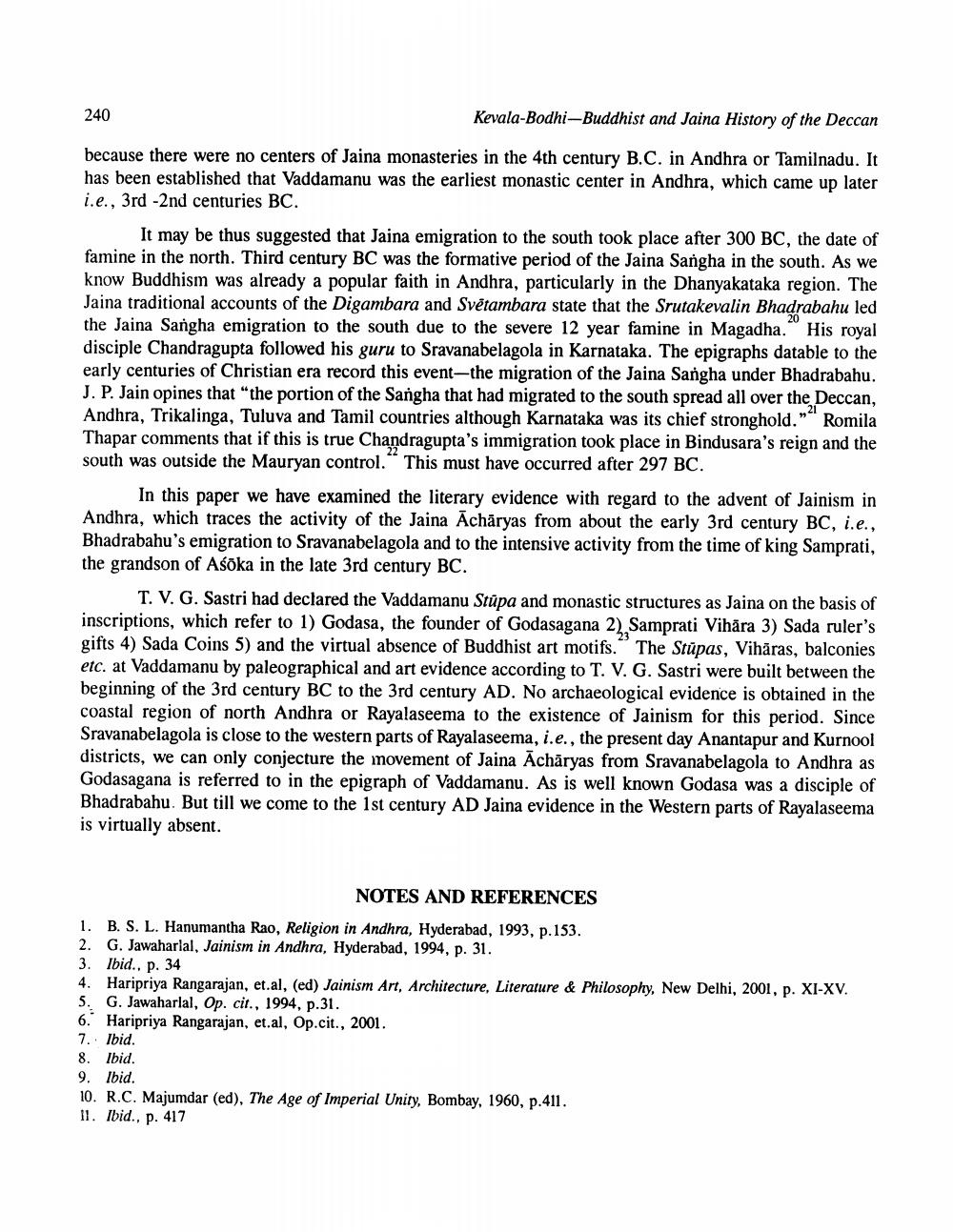________________
Kevala-Bodhi-Buddhist and Jaina History of the Deccan
because there were no centers of Jaina monasteries in the 4th century B.C. in Andhra or Tamilnadu. It has been established that Vaddamanu was the earliest monastic center in Andhra, which came up later i.e., 3rd -2nd centuries BC.
240
It may be thus suggested that Jaina emigration to the south took place after 300 BC, the date of famine in the north. Third century BC was the formative period of the Jaina Sangha in the south. As we know Buddhism was already a popular faith in Andhra, particularly in the Dhanyakataka region. The Jaina traditional accounts of the Digambara and Svetambara state that the Srutakevalin Bhadrabahu led the Jaina Sangha emigration to the south due to the severe 12 year famine in Magadha. His royal disciple Chandragupta followed his guru to Sravanabelagola in Karnataka. The epigraphs datable to the early centuries of Christian era record this event-the migration of the Jaina Sangha under Bhadrabahu. J. P. Jain opines that "the portion of the Sangha that had migrated to the south spread all over the Deccan, Andhra, Trikalinga, Tuluva and Tamil countries although Karnataka was its chief stronghold." Thapar comments that if this is true Chandragupta's immigration took place in Bindusara's reign and the south was outside the Mauryan control." This must have occurred after 297 BC.
In this paper we have examined the literary evidence with regard to the advent of Jainism in Andhra, which traces the activity of the Jaina Acharyas from about the early 3rd century BC, i.e.. Bhadrabahu's emigration to Sravanabelagola and to the intensive activity from the time of king Samprati, the grandson of Asoka in the late 3rd century BC.
T. V. G. Sastri had declared the Vaddamanu Stupa and monastic structures as Jaina on the basis of inscriptions, which refer to 1) Godasa, the founder of Godasagana 2) Samprati Vihara 3) Sada ruler's gifts 4) Sada Coins 5) and the virtual absence of Buddhist art motifs." The Stūpas, Vihāras, balconies etc. at Vaddamanu by paleographical and art evidence according to T. V. G. Sastri were built between the beginning of the 3rd century BC to the 3rd century AD. No archaeological evidence is obtained in the coastal region of north Andhra or Rayalaseema to the existence of Jainism for this period. Since Sravanabelagola is close to the western parts of Rayalaseema, i.e., the present day Anantapur and Kurnool districts, we can only conjecture the movement of Jaina Acharyas from Sravanabelagola to Andhra as Godasagana is referred to in the epigraph of Vaddamanu. As is well known Godasa was a disciple of Bhadrabahu. But till we come to the 1st century AD Jaina evidence in the Western parts of Rayalaseema is virtually absent.
NOTES AND REFERENCES
1. B. S. L. Hanumantha Rao, Religion in Andhra, Hyderabad, 1993, p.153.
2. G. Jawaharlal, Jainism in Andhra, Hyderabad, 1994, p. 31.
3. Ibid., p. 34
XI-XV.
4. Haripriya Rangarajan, et.al, (ed) Jainism Art, Architecture, Literature & Philosophy, New Delhi, 2001, p. 5. G. Jawaharlal, Op. cit., 1994, p.31.
6. Haripriya Rangarajan, et.al, Op.cit., 2001.
7. Ibid.
8. Ibid.
9. Ibid.
10. R.C. Majumdar (ed), The Age of Imperial Unity, Bombay, 1960, p.411.
11. Ibid., p. 417




